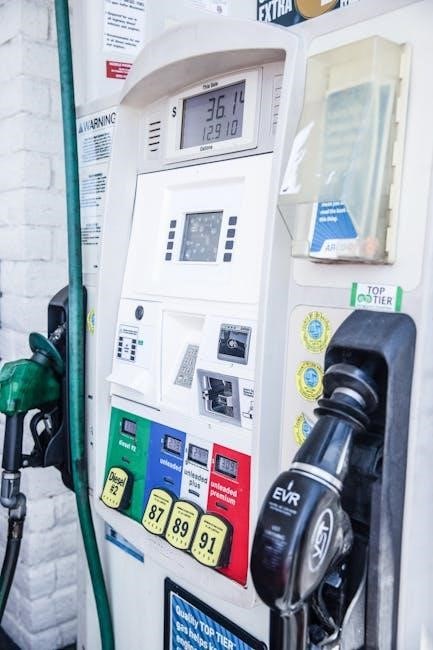This manual provides comprehensive guidance for the Cummins PT fuel pump, detailing installation, troubleshooting, and maintenance procedures to ensure optimal engine performance and proper fuel system operation․
Overview of the Cummins PT Fuel Pump System
The Cummins PT fuel pump system is a critical component in diesel engines, designed to pressurize and deliver fuel to the injectors․ It operates by drawing fuel from the tank and supplying it under high pressure, ensuring efficient combustion․ The system consists of key components like the pump, injectors, and fuel lines, working in harmony to maintain optimal engine performance․ Its design emphasizes simplicity and reliability, with features like color-coded pumps for easy identification by size and strength․ Regular checks and adjustments, as outlined in the manual, are essential to maintain fuel flow accuracy and prevent performance issues․ Proper system operation ensures reliable engine function under various conditions․
Importance of the Manual for Proper Fuel Pump Operation
The Cummins PT fuel pump manual is essential for ensuring proper operation, maintenance, and troubleshooting of the fuel system․ It provides detailed instructions for installing, removing, and adjusting the pump, as well as diagnostic steps for addressing common issues like no-start conditions or low power․ The manual also outlines critical checks and adjustments, such as idle speed and throttle position settings, to optimize fuel flow and engine performance․ By following the guidelines, users can prevent malfunctions, extend the system’s lifespan, and maintain peak efficiency․ Referencing the manual is crucial for understanding the PT fuel system’s design and ensuring all procedures are performed safely and correctly․
Key Components of the PT Fuel Pump System
The Cummins PT fuel pump system consists of several critical components designed to ensure efficient fuel delivery and engine performance․ The primary components include the PT fuel pump itself, which pressurizes and supplies fuel to the injectors, and the fuel injectors, which atomize and deliver fuel into the engine cylinders․ Additionally, the system features fuel lines, connectors, and a governor to regulate engine speed and fuel pressure․ The pump is also equipped with internal components such as gears, bearings, and seals, which ensure reliable operation․ Understanding these key components is vital for proper maintenance, troubleshooting, and ensuring optimal fuel system functionality․ Each part plays a crucial role in maintaining engine efficiency and performance․
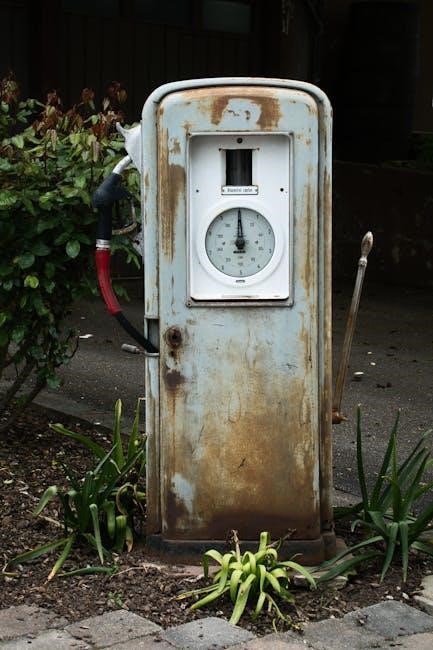
Structure and Function of the Cummins PT Fuel Pump
The Cummins PT fuel pump is designed to pressurize fuel for precise delivery to injectors, ensuring efficient engine operation․ Its robust structure includes gears, bearings, and seals․
Design and Construction of the PT Fuel Pump
The Cummins PT fuel pump is designed with durability and efficiency in mind, featuring a robust construction to withstand harsh operating conditions․ Built with high-grade materials, the pump ensures reliable performance and longevity․ Its compact design minimizes space requirements while maintaining optimal fuel flow․ The pump’s internal components, such as gears and bearings, are precision-engineered to deliver consistent pressure and flow rates․ The fuel pump is also color-coded according to its size and strength, simplifying identification and installation․ Advanced manufacturing techniques ensure tight tolerances and minimal wear, reducing the need for frequent repairs․ This design ensures the PT fuel pump meets the demands of modern diesel engines, providing precise fuel delivery for efficient combustion․
Role of the PT Fuel Pump in Engine Performance
The Cummins PT fuel pump plays a crucial role in engine performance by delivering pressurized fuel to the injectors, ensuring efficient combustion․ It maintains optimal fuel pressure and flow, adapting to varying engine demands․ Proper fuel delivery enhances power output, reduces emissions, and improves fuel efficiency․ The pump’s ability to supply consistent pressure ensures smooth engine operation across all RPM ranges․ Additionally, it supports precise fuel injection timing, which is vital for meeting emission standards and maximizing engine performance․ Without a functioning PT fuel pump, the engine may experience issues like poor acceleration, reduced power, or failure to start․ Thus, its role is essential for overall engine functionality and efficiency․
Pressure Regulation and Fuel Flow Mechanisms
The Cummins PT fuel pump employs advanced mechanisms to regulate fuel pressure and ensure consistent flow․ It uses internal components like pressure springs and valves to maintain optimal pressure levels, adapting to engine demands․ The pump’s design allows precise fuel delivery, preventing over-pressure or insufficient flow․ Fuel flow is controlled by the throttle position and engine load, ensuring efficient combustion․ The system also includes safety features to prevent pressure spikes․ Proper calibration and adjustments, as outlined in the manual, are essential to maintain these mechanisms․ Regular maintenance ensures the pump operates within specified parameters, delivering the right amount of fuel for smooth engine operation and performance․

Installation and Removal Instructions
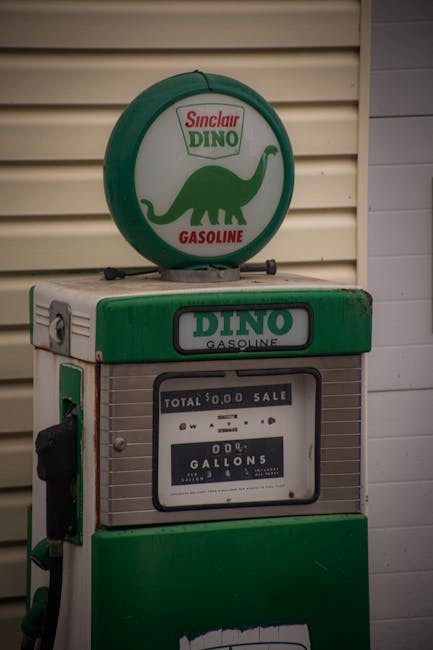
Follow detailed steps to remove and install the Cummins PT fuel pump, ensuring proper cleaning and preparation․ Adhere to safety guidelines and manufacturer specifications for optimal results․
Step-by-Step Guide to Removing the PT Fuel Pump
Clean the exterior of the injection pump and mounting surfaces to ensure a clear workspace․
Disconnect the electrical connectors from the pump․
Remove the mounting bolts and brackets securing the pump to the engine․
Carefully lift the pump from its position, taking note of any fuel lines or connections still attached․
Once removed, inspect the area for any remaining components or debris․
Properly label and store the removed parts for future reference or reinstallation․
Preparation for Installing the PT Fuel Pump
Before installing the PT fuel pump, ensure all necessary tools and materials are available․
Gather the new pump, mounting hardware, and gaskets․
Clean the installation area thoroughly to prevent contamination․
Disconnect the battery to avoid accidental engine start․
Drain the fuel system or relieve pressure as specified in the manual․
Inspect the fuel lines and connections for damage or leaks․
Refer to the manual for torque specifications and alignment guidelines․
Ensure the workspace is well-ventilated and clear of flammable materials․
Position the new pump correctly, aligning it with the engine’s mounting points․
Installation Procedure for the PT Fuel Pump
Align the PT fuel pump with the engine’s mounting surface, ensuring proper orientation․
Secure the pump using the provided bolts, tightening them in a star pattern to the specified torque․
Connect the fuel inlet and outlet lines, ensuring they are tightly sealed to prevent leaks․
Attach the electrical connector to the pump, verifying proper engagement․
Reconnect the battery and turn the ignition to test for fuel flow and pressure․
Inspect all connections for leaks or damage․
Refer to the manual for specific torque values and alignment guidelines․
Perform a final test run to ensure smooth engine operation․
Post-Installation Checks and Tests
After installing the PT fuel pump, perform the following checks:
Verify all connections are secure and properly tightened․
Test fuel flow by turning the ignition key without starting the engine․
Check for fuel leaks at connections and lines․
Use a pressure gauge to ensure fuel pressure matches specifications․
Start the engine and monitor for smooth operation․
Listen for unusual noises or vibrations․
Observe fuel flow and pressure under varying engine loads․
Allow the engine to run for a few minutes to check for inconsistencies․
Refer to the manual for specific test procedures and tolerances․
Document any issues for further troubleshooting or adjustment․
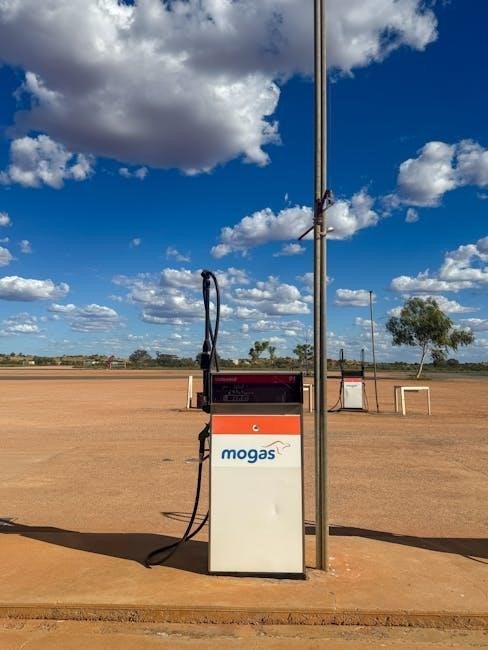
Adjustments and Calibrations
Adjustments and calibrations ensure optimal performance of the Cummins PT fuel pump․ Proper settings for idle speed, throttle position, and injector valve clearance are critical for efficient fuel flow and engine operation․
Idle Speed Adjustment Procedure
To adjust the idle speed on the Cummins PT fuel pump, follow these steps:
Ensure the engine is at operating temperature․
Manually position the throttle to the mid-position․
Press the MANUAL position on the AUTO/MANUAL switch․
Adjust the idle speed screw until the desired RPM is achieved․
Monitor the engine’s performance to ensure smooth operation․
Refer to the manual for specific torque and RPM specifications․
This procedure ensures optimal engine idle performance and fuel efficiency․
Throttle Position Adjustment for Optimal Fuel Flow
To adjust the throttle position for optimal fuel flow on the Cummins PT fuel pump, follow these steps:
Ensure the engine is at operating temperature․
Locate the throttle position sensor or actuator․
Use a screwdriver to adjust the throttle position screw․
Monitor the engine’s RPM and fuel flow to achieve the desired performance․
Refer to the manual for specific torque values or adjustment limits․
Test the engine under load to verify proper fuel delivery․
This ensures efficient fuel flow and engine performance․
Injector Valve Clearance Adjustment
Adjusting the injector valve clearance is crucial for maintaining proper fuel flow and engine performance․ To begin, gather the necessary tools, including a feeler gauge and a wrench․ Locate the injector valve and measure the current clearance using the gauge․ Compare this measurement to the specifications outlined in the manual․ If adjustments are needed, gently pry the valve and shim to achieve the correct clearance․ Tighten the valve securely after adjustment․ Finally, test the engine to ensure proper fuel delivery and performance․ Proper injector valve clearance ensures efficient combustion and optimal engine operation, as detailed in the Cummins PT fuel pump manual․
Fuel Pressure Calibration Steps
To calibrate the fuel pressure, begin by connecting a pressure gauge to the fuel system as specified in the Cummins PT manual․ Ensure the engine is at operating temperature and in idle mode․ Adjust the pressure regulator by turning the adjustment screw clockwise to increase pressure or counterclockwise to decrease it․ Monitor the gauge closely to achieve the recommended pressure range․ Once the desired pressure is set, test the engine under various loads to confirm stability; Document the final settings for future reference․ Proper calibration ensures efficient fuel delivery, optimal engine performance, and prevents potential damage to system components․ Always refer to the manual for specific pressure guidelines and safety precautions․
Governor Calibration for Proper Engine Performance
Governor calibration is essential for maintaining optimal engine performance and fuel efficiency․ Start by ensuring the engine is at idle and the fuel system is properly pressurized․ Locate the governor adjustment screws on the PT fuel pump․ Turn the idle screw clockwise to increase idle speed or counterclockwise to decrease it, monitoring the tachometer for the desired RPM․ Next, adjust the load screw to regulate fuel flow under varying engine loads․ Fine-tune the settings by testing the engine under different conditions․ Proper calibration ensures smooth operation, reduces emissions, and prevents engine damage․ Always refer to the Cummins PT manual for specific calibration instructions and safety guidelines to achieve precise control over engine performance․
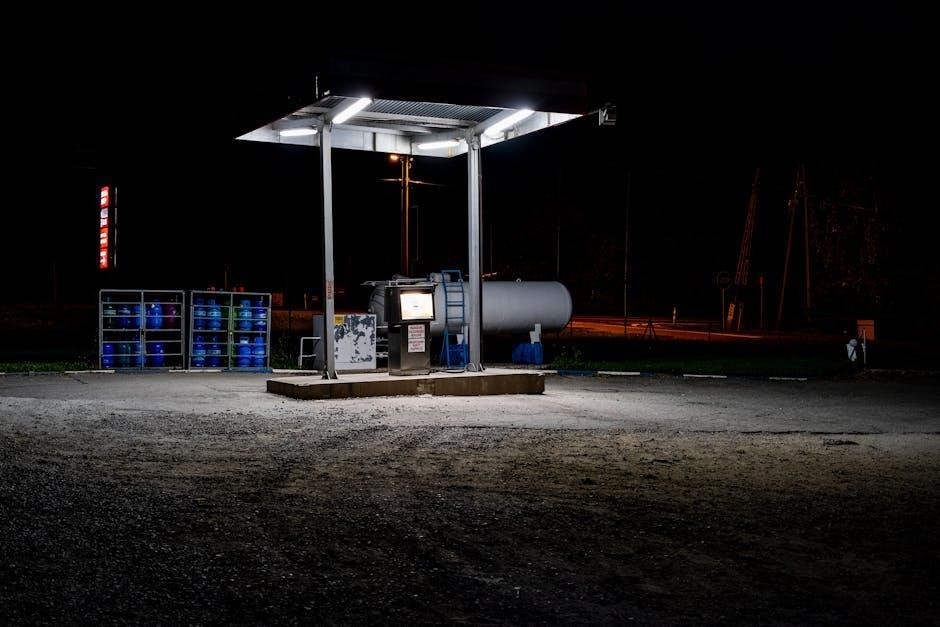
Troubleshooting Common Issues
This section addresses common PT fuel pump issues, such as no start or low power, and provides diagnostic steps to identify and resolve malfunctions efficiently․
Identifying Common Problems with the PT Fuel Pump
The Cummins PT fuel pump can experience issues such as low fuel pressure, excessive noise, or failure to prime․ Common problems include contaminated fuel, worn components, or faulty pressure regulators․ Error codes may indicate pump malfunction, while physical signs like leaks or corrosion should be inspected․ Diagnosing these issues involves checking fuel flow, pressure readings, and electrical connections․ Addressing these problems early prevents engine performance degradation and ensures reliable operation․ Regular maintenance, as outlined in the manual, helps identify and resolve issues before they escalate․ Proper troubleshooting techniques are essential for maintaining the PT fuel pump’s efficiency and longevity․ Always refer to the manual for specific diagnostic steps and solutions․
Diagnostic Steps for Fuel Pump Malfunction
Diagnosing a malfunctioning Cummins PT fuel pump involves systematic checks to identify the root cause․ Start by monitoring fuel pressure using a pressure gauge to ensure it meets specifications․ Listen for unusual noises, such as whining or grinding, which may indicate internal wear․ Inspect the fuel system for leaks or contamination, as dirty fuel can disrupt pump operation․ Check electrical connections and fuses to ensure proper power supply․ Review error codes using a diagnostic scan tool for specific fault indications․ Perform a manual test by priming the pump to confirm fuel flow․ If issues persist, refer to the manual for advanced troubleshooting procedures․ Always follow safety guidelines when handling fuel systems․ Proper diagnostics ensure accurate repairs and prevent further damage․ Regular maintenance can help avoid such malfunctions․
Addressing No Start or Low Power Issues
No start or low power issues with the Cummins PT fuel pump often stem from insufficient fuel pressure or flow․ Begin by checking the fuel pump’s operation and ensuring proper priming of the system․ Inspect the fuel lines for blockages or leaks, as restricted flow can prevent the engine from starting or maintaining power․ Verify the electrical connections to the pump and ensure the fuse or relay is functioning․ If the issue persists, use a diagnostic tool to check for error codes related to the fuel system․ Refer to the manual for specific test procedures, such as measuring fuel pressure or testing the pump’s solenoid․ Addressing these issues promptly ensures reliable engine performance and prevents further damage to the fuel system․ Regular maintenance can help avoid such problems․
Understanding Error Codes Related to the Fuel Pump
Modern Cummins engines utilize error codes to identify issues within the fuel system, including the PT fuel pump; These codes, often displayed on the engine’s control panel or retrieved using diagnostic tools, provide specific insights into malfunctions․ Common codes related to the fuel pump may indicate low fuel pressure, excessive flow, or pump failure․ Referencing the manual is crucial, as it details the meaning of each code and the corresponding troubleshooting steps․ For example, a code indicating low fuel pressure could point to a faulty pump, clogged fuel lines, or a malfunctioning pressure regulator․ Addressing these codes promptly ensures minimal downtime and prevents potential engine damage․ Always consult the manual for accurate interpretations and repair guidance․ Regular system checks can help identify issues before they escalate․
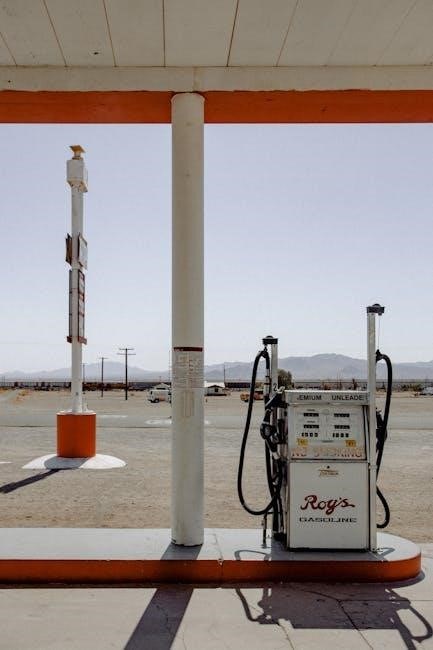
Maintenance and Repair
Regular maintenance ensures optimal performance of the Cummins PT fuel pump․ Cleaning, inspecting, and replacing worn components are essential tasks outlined in the manual for longevity․
Routine Maintenance Schedule for the PT Fuel Pump
Routine maintenance is crucial for ensuring the longevity and efficiency of the Cummins PT fuel pump․ Regular inspections should be performed every 100 to 200 hours of operation․ This includes checking fuel lines for leaks, inspecting the pump’s electrical connections, and verifying the fuel filter’s condition․ Replace the fuel filter every 500 hours or as specified in the manual․ Additionally, clean the pump’s exterior and internal components periodically to prevent debris buildup․ Ensure proper lubrication of moving parts and monitor fuel pressure levels․ Address any worn or damaged components promptly to avoid system failure․ Following this schedule ensures optimal performance and prevents costly repairs․
Cleaning and Inspection Procedures
Cleaning and inspecting the Cummins PT fuel pump is essential for maintaining its efficiency and longevity․ Begin by disconnecting the fuel lines and electrical connections, then carefully disassemble the pump to access internal components․ Use a soft-bristle brush and mild solvent to remove dirt and debris․ Inspect all parts for wear, corrosion, or damage, paying special attention to the pump’s gears, seals, and diaphragm․ Replace any damaged components immediately․ Reassemble the pump in the reverse order of disassembly, ensuring all connections are secure․ Finally, perform a pressure test to verify proper function․ Regular cleaning and inspection help prevent fuel leaks and ensure consistent engine performance․
Replacing Worn or Damaged Components
Replacing worn or damaged components in the Cummins PT fuel pump is crucial for maintaining its efficiency and preventing engine damage․ Begin by cleaning the pump and its surroundings to avoid contamination․ Disconnect the fuel lines and electrical connections, taking care to prevent fuel spillage and electrical issues․ Disassemble the pump by removing bolts or fasteners in the correct order to access internal parts․ Inspect each component for wear or damage, referring to the manual’s guidelines for acceptable wear specifications․ Replace any worn-out parts with new, compatible components that meet manufacturer standards․ Reassemble the pump in the reverse order of disassembly, ensuring all connections are secure․ After reassembly, reconnect the fuel lines and electrical connections, and perform tests like pressure checks or leak inspections to ensure proper function; Adhere to safety precautions, such as working in a well-ventilated area and avoiding open flames or sparks, as outlined in the manual․ By following these steps, you can effectively replace worn or damaged components and maintain optimal pump performance․
Advanced Repair Techniques for the PT Fuel Pump
Advanced repair techniques for the Cummins PT fuel pump involve specialized procedures to address complex issues․ Pressure testing the pump and its internal components can help identify leaks or internal damage․ In some cases, disassembling the pump further may be required to inspect internal gears or seals․ Using specialized tools, such as a hydraulic test bench, can help verify pump performance under simulated operating conditions․ Additionally, calibration of the pump’s internal components, like the pressure regulator, may be necessary to restore proper fuel flow and pressure․ Always consult the manual for specific torque values and alignment procedures to ensure accurate repairs․ Safety precautions, such as proper ventilation and avoiding open flames, are essential when handling fuel system components․ By following these advanced techniques, technicians can effectively diagnose and repair intricate issues with the PT fuel pump, ensuring reliable engine performance․

Technical Specifications and Compatibility
The Cummins PT fuel pump is designed to meet specific pressure and flow rate requirements, ensuring compatibility with various Cummins engine models, including the X15 and L9 series․
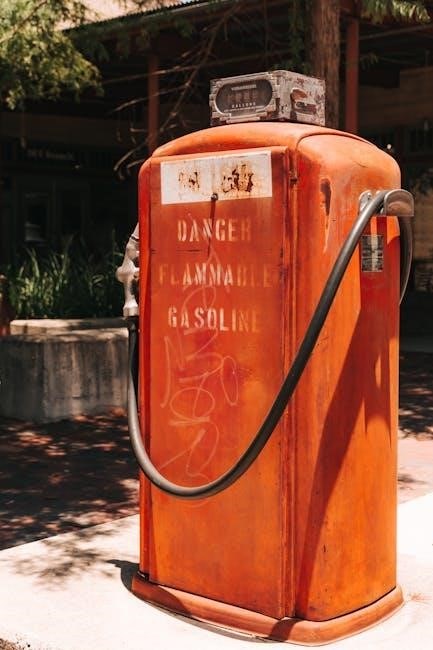
Specifications of the Cummins PT Fuel Pump Models
The Cummins PT fuel pump models are designed to deliver precise fuel flow and pressure, with specifications varying based on engine requirements․ These pumps are engineered to handle high-pressure demands, ensuring optimal performance across various Cummins engine applications․ Key specifications include flow rates, pressure ranges, and compatibility with specific engine models․ The PT fuel pump is constructed with durable materials to withstand harsh operating conditions․ Each model is color-coded for easy identification, corresponding to its performance characteristics․ Proper installation and calibration are critical to meet the outlined specifications, ensuring efficient fuel delivery and engine operation․ Refer to the manual for detailed model-specific technical data and compatibility guidelines․
Performance Characteristics of the PT Fuel Pump
The Cummins PT fuel pump is engineered to deliver consistent and reliable performance, ensuring precise fuel flow and pressure regulation․ Its robust design enables it to handle a wide range of engine demands, from low idle to high-speed operations; The pump’s ability to maintain optimal fuel pressure ensures efficient combustion and engine performance․ Manual adjustments allow fine-tuning of throttle position and idle speed for customized operation․ The PT pump is also designed for quiet operation and minimal vibration, enhancing overall driving comfort․ Its performance characteristics make it a critical component in maintaining the efficiency and power of Cummins engines across various applications․
Compatibility with Different Cummins Engines
The Cummins PT fuel pump is designed to be compatible with a variety of Cummins engines, ensuring versatility and ease of integration․ Its universal design allows it to function seamlessly across different engine models, from heavy-duty trucks to industrial machinery․ The pump’s adaptability is supported by its interchangeable components, making it suitable for diverse applications․ Detailed specifications in the manual ensure proper installation and operation across compatible engines․ This compatibility minimizes the need for multiple pump types, streamlining maintenance and reducing costs․ The PT pump’s widespread compatibility underscores Cummins’ commitment to providing reliable and efficient solutions for a broad range of engine needs․
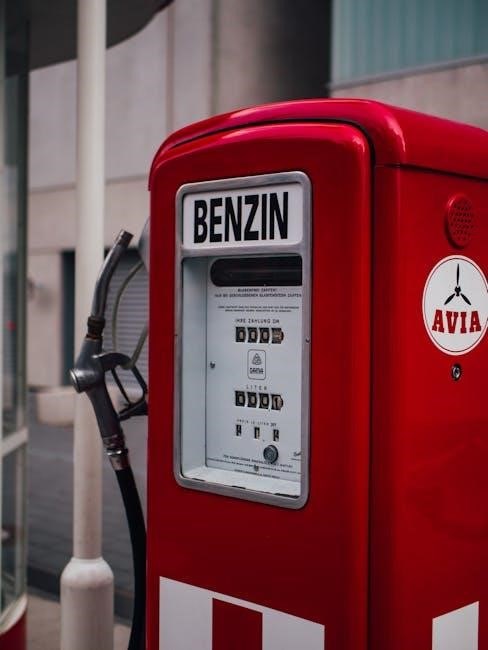
Safety Precautions and Best Practices
Always follow safety guidelines when handling the PT fuel pump, including proper protective equipment and fuel handling procedures to ensure safe operation and environmental protection․
Safety Guidelines for Handling the PT Fuel Pump
When handling the Cummins PT fuel pump, always wear protective gloves and eyewear to prevent injury from sharp edges or fuel splashes․ Ensure the engine is turned off and the battery is disconnected to avoid accidental start-ups․ Work in a well-ventilated area to prevent inhalation of fuel vapors․ Never smoke or expose open flames near the fuel system, as fuel is highly flammable․ Use only approved tools to avoid generating sparks; Keep the workspace clean and free from clutter to minimize tripping hazards․ Always follow the manufacturer’s instructions for handling fuel and electrical components․ In case of a fuel leak, evacuate the area immediately and follow emergency procedures․ Proper safety practices ensure both personal and equipment protection․
Proper Workspace Setup for Maintenance
Setting up a proper workspace is essential for safe and efficient maintenance of the Cummins PT fuel pump․ Ensure the area is clean, dry, and free from debris․ Use a flat, stable work surface to prevent tools or components from rolling away․ Proper lighting is crucial; use a high-intensity work light to illuminate the workspace clearly․ Keep all tools and replacement parts organized and within reach to minimize downtime․ Wear protective gear, including gloves and safety glasses, and ensure the area is well-ventilated to avoid inhaling fuel vapors․ Label all disconnected components and store them securely to prevent misplacement․ Use jack stands or lifts for engine stability if working on a vehicle․ Always have a fire extinguisher nearby in case of emergencies․ A well-prepared workspace enhances safety and efficiency during maintenance tasks․
Emergency Procedures in Case of Fuel Leaks
In the event of a fuel leak while working with the Cummins PT fuel pump, act swiftly to prevent hazards․ First, shut off the engine and any fuel supply lines immediately․ Evacuate the area to avoid inhaling fuel vapors and ensure the space is well-ventilated․ Use absorbent materials to contain the spill, and prevent it from reaching drains or waterways․ Do not attempt to operate the engine until the leak is fully repaired․ Refer to the manual for specific instructions on addressing fuel pump leaks․ Keep a fire extinguisher nearby and avoid smoking or using open flames․ Follow environmental regulations for proper cleanup and disposal of spilled fuel․ Always prioritize safety to prevent accidents and environmental damage․
The Cummins PT Fuel Pump Manual is an essential resource for optimal engine performance, safety, and maintenance․ Follow guidelines meticulously for reliable operation and troubleshooting․
This manual serves as a detailed guide for understanding and maintaining the Cummins PT fuel pump system․ It covers installation, removal, and troubleshooting procedures, ensuring proper engine performance․ Routine maintenance schedules and adjustment guidelines are provided to optimize fuel flow and pressure regulation․ Diagnostic steps and error code interpretations help address common issues like no-start conditions or low power․ Safety precautions and workspace setup recommendations are emphasized to ensure safe handling and operation․ By following the outlined procedures, users can effectively manage and repair the PT fuel pump, extending its lifespan and maintaining peak engine efficiency․ This manual is an essential resource for technicians and operators working with Cummins engines․
Final Tips for Effective Use of the PT Fuel Pump Manual
To maximize the effectiveness of the Cummins PT fuel pump manual, always follow safety guidelines and ensure proper workspace setup․ Regularly review the manual for updates and refer to specific sections during maintenance or repairs․ Use calibrated tools and adhere strictly to the outlined procedures to avoid component damage․ Familiarize yourself with error codes and diagnostic steps to address issues promptly․ Maintain a clean workspace and label components during disassembly for easy reassembly․ Finally, keep the manual readily accessible and updated to ensure optimal performance and longevity of the PT fuel pump system․ Proper adherence to these tips will enhance efficiency and reliability in managing the fuel pump․
